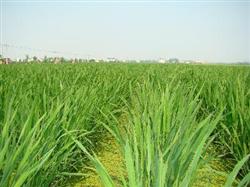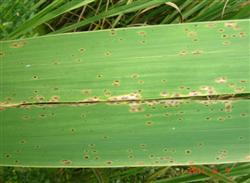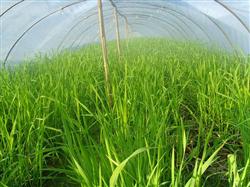Occurrence characteristics and integrated control of diseases and insect pests in alpine Zizania caduciflora

The development of alpine Zizania latifolia is an important way to increase farmers' income in mountain areas, but in the process of production, serious diseases and insect pests have become an important obstacle to pollution-free production of Zizania caduciflora. In this paper, the types and integrated control techniques of main diseases and insect pests of Zizania caduciflora are introduced as follows. 1. The main diseases and insect pests (1) Zizania latifolia white rust. The rust of Zizania latifolia is mainly harmful to the leaves of Zizania latifolia, and it also occurs on the leaf sheath. On the front of leaves and sheaths of Zizania latifolia, yellow or ferruginous blister spots were scattered on the front and sheath of Zizania latifolia, which were ruptured and rusty powdery. In the later stage, the leaves and leaf sheaths showed gray to black blister spots, long strip, and the epidermis was not easy to break. After susceptibility to the disease, the growth potential of the plant weakens, and the leaves are withered and yellow in severe cases. According to the observation of our institute in Dalan experimental site in the past two years, the disease generally began in late April, and the peak period was in late June and early August. Zizania latifolia (2) hemp spot of Zizania caduciflora. The flax spot of Zizania caduciflora is mainly harmful to leaves, and leaf sheaths can also occur. At the beginning of the disease, the leaves were dense brown dots, and then expanded into brown spindle-shaped or oval spots, shaped like sesame seeds. There is a yellow halo around the lesion, and the center becomes grayish white in the later stage. The disease spot of leaf sheath is larger and the number is less. When the humidity is high, the disease spot grows dark gray to black mildew, namely conidiophores and conidia. When the disease is serious, the leaves gradually die down or inward from the tip or edge of the leaves, and finally the leaves dry up, and the disease spots of the leaf sheath are large and few. The disease began to occur in the first and middle of June, when the average temperature was 20 ℃, and the peak period was in the middle of July. Zizania caduciflora (3) sheath blight. The sheath blight of Zizania caduciflora is mainly harmful to leaf sheath, followed by damage to leaves. At first, a water-stained dark green oval spot appeared on the leaf sheath near the surface of the water, and then expanded into a moire, and in severe cases, the leaf sheath and leaves were soft rot. High temperature and humidity were the main epidemic conditions of the disease. The disease began to occur at 22 ℃ in the field, and the most favorable condition was 25-32 ℃. At this time, the disease spread rapidly in case of continuous overcast and rain. Zizania caduciflora (4). The first generation of Chilo suppressalis damaged Zizania caduciflora from the middle of May to the end of June, and the first generation of Chilo suppressalis damaged the second generation of Chilo suppressalis from late July to early August. The larvae gather and feed on the leaf sheath to form a discolored leaf sheath, which can be dispersed with the increase of the age of the larvae, and eat the leaves of the human heart, resulting in a withered heart. Zizania caduciflora (5) planthopper. Mainly evergreen planthopper, nymphs and adults suck juice near the heart leaf and the midvein of young leaves, and there is often white waxy powder in the vicinity. The damage time is generally from mid-May to late July, and planthopper damage can also induce diseases. No, no, no. Integrated control technology (1) agricultural control. One is to clean up the countryside, burn the residual leaves of the field plants before winter, and reduce the source of overwintering insects and the primary infection source of bacteria in the following year. In the process of production, it is necessary to remove yellow leaves from seedlings, remove the residual leaves of diseased plants in time and deal with them centrally, so as to enhance ventilation and light transmission in the field. The second is scientific fertilizer and water management, mainly adopting technical measures such as applying sufficient base fertilizer, properly increasing phosphorus, potassium and zinc fertilizer, controlling the amount of nitrogen fertilizer, timely and appropriately shelving the field, so as to make the plant grow healthily and enhance the ability of stress resistance. Third, when the stem borer (Chilo suppressalis and Chilo suppressalis) is about to pupate, drain the field water, reduce the pupation position of the larvae, irrigate deep water in the peak period of pupation, drown part of the pupae and reduce its base. The fourth is to establish a system of intercropping and rotation. Rotation is needed after two consecutive seasons of planting in Zizania latifolia, preferably with dry cropping. (2) physical control. Making use of the phototaxis of pests, yellow sticky plates were used to trap and kill long green planthoppers and aphids, and sex pheromones and frequency vibrating insecticidal lamps, black lights and other insecticidal lamps were used to trap and kill the adults of Chilo suppressalis and Chilo suppressalis. (3) Biological control. Maintain a good ecological environment, protect and make use of pest natural enemies, such as predatory natural enemies spiders and frogs, and raise ducks, fish and other pests and weeds in Zizania caduciflora fields.
- Prev

High temperature and high humidity Zizania latifolia is prone to flax leaf spot.
Leaf spot of Zizania caduciflax is a fungal disease. In recent years, with the increasing area of Zizania caduciflora, the scope of the disease has gradually expanded, and the disease is becoming more and more serious. The disease can occur in the whole growing period of Zizania caduciflora. The main harm to the leaves, the initial appearance of yellow-brown spots on the leaves, and then expanded into sesame-sized brown spots, a few into.
- Next

Key points of protected cultivation and management of Zizania caduciflora in greenhouse at present
In the early spring of this year, the growth process of protected cultivation of Zizania caduciflora in greenhouse was 5-7 days later than usual due to the rare continuous rain and low temperature in history. It is necessary to seize the interval of sunny days to step up the field management of Zizania caduciflora cultivation in greenhouse facilities, and speed up the healthy growth of Zizania caduciflora under greenhouse facilities.
Related
- Where is it suitable to grow horseradish in China? it is expected to see the middle altitude horseradish in Alishan.
- How to prevent tomato virus disease reasonably? (Control methods included)
- Many people like to plant towel gourd on the balcony. What are the main points of this method and management?
- What crops can chili peppers be mixed with?
- Fertilization techniques and matters needing attention in Tomato
- What are the grafting techniques for peach seedlings in spring?
- Harm and control methods of root swelling disease of Chinese cabbage
- What are the pests of sweet potatoes? How to prevent and cure it?
- Symptoms, causes and Control methods of navel Rot in Tomato
- The cause of "Cucumber rotten bibcock" in Farmers' planting Cucumber and its Control Plan

